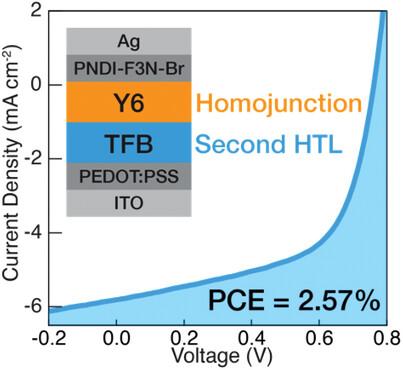High-Efficiency Y6 Homojunction Organic Solar Cells Enabled by a Secondary Hole Transport Layer
IF 13
2区 材料科学
Q1 CHEMISTRY, MULTIDISCIPLINARY
引用次数: 0
Abstract
Y6 homojunction solar cells are prepared using the exciton/electron-blocking material poly[9,9-di-n-octylfluorene-alt-N-(4-sec-butylphenyl)diphenylamine] (TFB) as a secondary hole transport layer material in conjunction with PEDOT:PSS. Using this device architecture, a maximum power conversion efficiency (PCE) of 2.57% is achieved, which is the highest reported thus far for a solution-processed small molecule homojunction organic photovoltaic (OPV) device. The devices display an unexpectedly low thickness dependence, with the average PCE only decreasing by ≈17% when the Y6 active layer thickness is increased from 80 to 300 nm. Time-resolved photoluminescence measurements show that the TFB does not contribute to charge generation through photoinduced hole or electron transfer. However, transient absorption spectroscopy on thin films of neat Y6 and a 1:1 blend of Y6:TFB shows that the TFB enhances the formation of the long-lived Y6 intermolecular charge-transfer state in the blend film. It is found that careful selection of the electron transport layer (ETL) is required to avoid unintended charge generation at the interface with Y6 so as to ensure that the device is a true homojunction. The improved efficiency of this architecture is attributed to the electron-blocking and hole-extraction effects of the TFB layer.

求助全文
约1分钟内获得全文
求助全文
来源期刊

Small
工程技术-材料科学:综合
CiteScore
17.70
自引率
3.80%
发文量
1830
审稿时长
2.1 months
期刊介绍:
Small serves as an exceptional platform for both experimental and theoretical studies in fundamental and applied interdisciplinary research at the nano- and microscale. The journal offers a compelling mix of peer-reviewed Research Articles, Reviews, Perspectives, and Comments.
With a remarkable 2022 Journal Impact Factor of 13.3 (Journal Citation Reports from Clarivate Analytics, 2023), Small remains among the top multidisciplinary journals, covering a wide range of topics at the interface of materials science, chemistry, physics, engineering, medicine, and biology.
Small's readership includes biochemists, biologists, biomedical scientists, chemists, engineers, information technologists, materials scientists, physicists, and theoreticians alike.
 求助内容:
求助内容: 应助结果提醒方式:
应助结果提醒方式:


